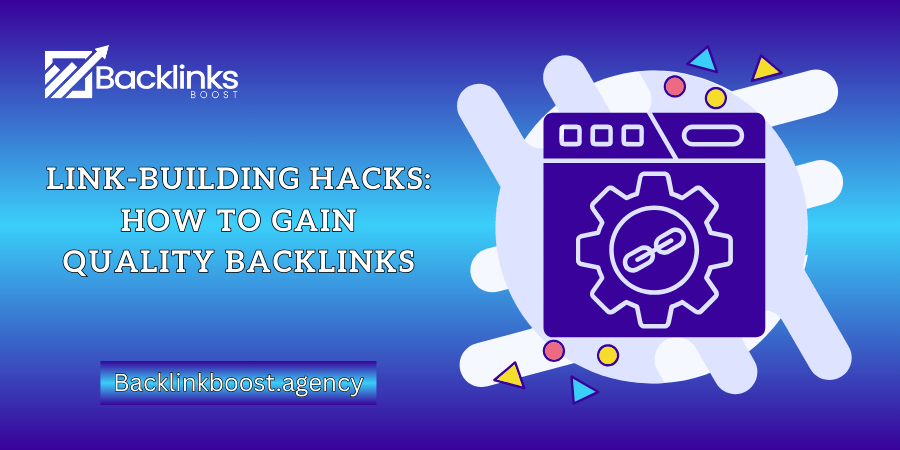In the competitive world of SEO, gaining high-quality backlinks is a vital strategy for improving your website’s authority and search engine rankings. However, not all backlinks are created equal. In this post, we’ll explore the most effective link-building hacks that can help you secure valuable backlinks to boost your online presence. From creating linkable content to reclaiming lost links and building relationships with industry influencers, this guide will provide actionable insights for anyone looking to enhance their SEO efforts through smart, strategic link-building techniques.
Understanding High-Quality Backlinks
Backlinks, also known as inbound links, play a crucial role in search engine optimization (SEO). However, not all backlinks are created equal. To truly benefit your website’s SEO efforts, it’s important to focus on acquiring high-quality backlinks.
Characteristics of a Valuable Backlink
High-quality backlinks possess certain characteristics that distinguish them from lower-quality links. These factors determine how much weight a search engine, such as Google, places on a particular backlink. Here are the core characteristics to consider:
1. Domain Authority and Page Authority
A backlink from a website with high domain authority (DA) and page authority (PA) is typically more valuable than one from a lesser-known site. Domain authority is a metric developed by companies like Moz to predict how well a website will rank on search engine result pages (SERPs). The higher the DA of a linking site, the more beneficial the backlink will be for your own site’s SEO.
2. Contextual Relevance
For a backlink to be truly effective, it should come from a website that is relevant to your niche or industry. If your site is about technology, a backlink from a well-regarded tech blog will carry more weight than one from a fashion website. Search engines favor links that come from content-rich, relevant sources because they demonstrate genuine industry connections.
3. Placement of the Link
Where a backlink appears on a webpage also affects its value. Links placed naturally within the body of a page or article are far more valuable than those found in sidebars, footers, or comment sections. These in-content links are considered more organic, which search engines appreciate.
4. Anchor Text Optimization
Anchor text refers to the clickable text in a hyperlink. When the anchor text is descriptive and relevant to the content it links to, it boosts the value of the backlink. For example, a link with anchor text like “best SEO strategies” is more beneficial than generic anchor text like “click here.”
Relevance, Authority, and Trust Factors
To further understand what makes a backlink valuable, it’s important to analyze the relevance, authority, and trust associated with the source of the backlink. These three factors significantly influence how search engines assess the quality of a backlink.
1. Relevance
Relevance is critical in backlink evaluation. A backlink from a site or page that covers a topic related to your own content is more impactful than one from an unrelated source. Search engines strive to deliver the most relevant content to users, so links from related websites signal to them that your content is a valuable resource within that niche.
2. Authority
Authority refers to how established and respected a website is in its field. Websites that regularly produce high-quality, trustworthy content and have a large following are seen as authoritative. A backlink from an authoritative website carries more SEO power and can significantly boost your own site’s rankings. Authority is closely tied to domain authority and other reputation metrics.
3. Trust
Trust is a lesser-known but equally important factor in backlink evaluation. Search engines assess trustworthiness based on the linking site’s history, transparency, and reputation. Sites with a good track record of producing accurate, non-spammy content, and which follow ethical SEO practices, are deemed trustworthy. Getting backlinks from trusted websites enhances your own site’s trustworthiness in the eyes of search engines, which can lead to higher rankings.
Creating Linkable Assets That Attract Backlinks

One of the most effective ways to build high-quality backlinks is by creating content that naturally attracts links, also known as “linkable assets.” These are pieces of content that offer such value that other websites want to link to them as a resource for their audience.
Skyscraper Content
The skyscraper technique is a popular strategy in SEO for creating content that stands out and naturally attracts backlinks. This method involves finding existing high-performing content, improving upon it, and promoting your updated version. The idea is to “build a taller skyscraper” by offering a more comprehensive, valuable resource that others will want to link to.
1. Researching High-Performing Content
The first step in creating skyscraper content is to identify topics within your niche that are already performing well. Tools like Ahrefs or BuzzSumo can help you find articles that have generated a significant number of backlinks or social shares. These are often listicles, how-to guides, or in-depth resources that provide detailed information.
2. Improving the Content
Once you have identified a high-performing piece of content, your next task is to make it even better. This can be done by adding more up-to-date information, incorporating visual elements like infographics or videos, or expanding the scope of the topic. The goal is to create something that not only matches the quality of the original but exceeds it in terms of value, depth, and user experience.
3. Promoting Your Skyscraper Content
After crafting your improved content, promotion is key. Reach out to websites that have already linked to similar content and offer them your improved version. This outreach process is an essential part of the skyscraper technique and can help you secure valuable backlinks from authoritative websites.
Ultimate Guides and Evergreen Resources
Another effective way to attract backlinks is by creating ultimate guides and evergreen resources. These types of content are long-lasting, highly informative, and provide comprehensive coverage on a particular topic, making them prime targets for backlinks.
1. What is an Ultimate Guide?
An ultimate guide is a detailed, all-in-one resource that covers every aspect of a specific topic. It serves as a reference point that readers can return to time and time again. Because of its depth and value, ultimate guides are often seen as authoritative resources, which makes them attractive for other sites to link to.
For example, if you run a digital marketing blog, creating an “Ultimate Guide to SEO” that covers everything from keyword research to link-building strategies can serve as a comprehensive resource that others in your industry will want to reference.
2. Why Evergreen Content Attracts Backlinks
Evergreen content refers to material that remains relevant and useful over time. Unlike news articles or trend-based content, evergreen resources continue to provide value long after they are published. This type of content, such as “how-to” articles, frequently asked questions (FAQs), or detailed tutorials, attracts backlinks because it is continually relevant to readers and websites in your niche.
3. Updating and Maintaining Evergreen Resources
To maximize the link-building potential of evergreen content, it’s essential to keep it updated. By regularly refreshing your ultimate guides with new data, trends, and examples, you ensure that the content remains current and valuable. This not only improves its chances of attracting new backlinks but also keeps the content competitive in search engine rankings.
Leveraging Unlinked Mentions and Reclaiming Links

One of the more straightforward yet highly effective strategies for improving your website’s backlink profile is leveraging unlinked mentions and reclaiming lost or broken links. These techniques allow you to capitalize on existing opportunities by turning brand mentions and broken links into high-quality backlinks.
How to Find Unlinked Brand Mentions
Unlinked brand mentions occur when other websites reference your brand, product, or content without providing a hyperlink back to your website. These mentions represent a low-hanging fruit for acquiring new backlinks because the website is already discussing your brand, making it easier to request a link.
1. Using Monitoring Tools
To find unlinked mentions, the first step is to use tools that monitor online references to your brand. Tools like Google Alerts, Ahrefs Content Explorer, and BuzzSumo allow you to track mentions of your brand, products, or even key employees. Set up alerts for different variations of your brand name or product keywords to ensure you capture a wide range of mentions.
2. Manually Reviewing Mentions
Once you have a list of mentions, you’ll need to manually check each one to see if there’s a backlink to your site. Sometimes, the mention may be in the form of a company name, product name, or even a quote from one of your articles, but without an accompanying hyperlink. By identifying these instances, you can take the next step: outreach.
3. Reaching Out for a Link
After identifying unlinked mentions, reach out to the website’s owner or content creator. Since they’ve already mentioned your brand, the relationship is already warm, and the request for a link is not intrusive. Politely explain the benefit of linking to your site, such as providing their readers with a direct source for more information. In many cases, websites will be happy to add the link.
Reclaiming Lost or Broken Links
Lost or broken links can significantly impact your backlink profile. These occur when websites that previously linked to your content no longer do so, either because the link broke, the page was removed, or the site was redesigned. Reclaiming these links helps restore valuable SEO equity without creating new content.
1. Identifying Lost or Broken Links
The first step in reclaiming lost links is identifying which ones are broken. SEO tools like Ahrefs, Moz, and SEMrush provide reports on backlinks, including any that have been lost over time. By analyzing these reports, you can see which pages once linked to your content but no longer do.
2. Fixing Broken Internal Links
Broken links can occur on your own site as well, especially if you’ve deleted or moved content. Ensure that all internal links are functioning properly by using website auditing tools. Once identified, you can set up 301 redirects to guide users (and search engines) from the broken link to a working page. This not only improves the user experience but helps retain link value.
3. Reaching Out to Reclaim Lost Backlinks
For lost external backlinks, reach out to the site owner and explain the issue. This could involve notifying them that the page they linked to is no longer accessible or requesting that they update the link to point to a newer version of the content. Offering a suitable replacement page increases the likelihood that the website will restore the link, helping you reclaim valuable SEO juice.
Using Proven Content Formats to Earn Links

Certain types of content naturally attract more backlinks because they provide unique value to users and other content creators. By focusing on proven content formats like infographics, original data, tools, and templates, you can create assets that encourage others to link to your website.
Infographics, Studies, and Original Data
Content that presents complex information in a simple, digestible format is highly shareable and linkable. Infographics, research studies, and original data are among the most effective formats for earning backlinks.
1. Infographics
Infographics combine visual elements with concise, easily understood information, making them an ideal format for sharing data, statistics, or complex concepts. Since many people are visual learners, infographics can be more engaging than text-heavy articles.
When you create an infographic that presents valuable information in an attractive design, it becomes a resource that other websites want to share. By including an embed code or encouraging others to link to your infographic, you can generate backlinks from a wide range of sources, including blogs, news outlets, and educational websites.
2. Studies and Research
Original research and data-driven content are highly valuable because they provide fresh insights that other websites can reference. Conducting surveys, case studies, or scientific research allows you to produce content that few others can offer. Websites and blogs in your niche will often link to your original study to support their own arguments or provide authoritative references for their readers.
By publishing studies with clear, well-researched data and presenting the findings in an engaging format (such as charts or graphs), you position your website as an authoritative source. This naturally attracts backlinks from other reputable websites.
3. Original Data and Statistics
Original data, such as industry reports, benchmarks, and statistical analyses, offer something unique that’s hard to replicate. Websites frequently link to original data when discussing trends or citing statistics, which can lead to long-term backlink growth as your content continues to be referenced over time. Regularly updating your data ensures that your site remains relevant and that your statistics are used as a reliable source across the web.
Tools, Templates, and Resources
In addition to data-driven content, practical tools, templates, and other useful resources are excellent for earning backlinks. These types of content provide immediate value to users, making them more likely to be shared and linked to by others in your niche.
1. Free Tools
Free online tools, such as calculators, generators, or assessment tools, offer utility that attracts consistent traffic and backlinks. When you provide a free tool that solves a specific problem, such as an SEO audit tool or a budget planner, other websites in your industry are likely to recommend and link to it. The functionality and usefulness of the tool encourage users to keep coming back, while also earning your site backlinks from reviews and recommendations.
2. Templates
Templates offer a convenient, time-saving solution for users, making them a valuable resource for earning backlinks. Whether it’s a downloadable content calendar, resume template, or email outreach template, providing customizable resources positions your website as a helpful reference. Websites that write about productivity, business management, or industry-specific topics often link to template libraries as useful tools for their readers.
3. Resource Libraries
Compiling resource libraries—collections of helpful tools, documents, or references—can become a go-to asset for your audience and others in your industry. A well-curated resource page that aggregates valuable information, templates, or tools can attract backlinks from websites that want to offer their readers a comprehensive resource. By regularly updating the library and expanding its offerings, you increase the chances of other sites linking to it as a reliable reference.
Building Backlinks From Outdated and Broken Resources

One of the most effective yet underutilized methods of building backlinks is through outdated and broken resources. Websites often contain links to pages that no longer exist or point to outdated information, creating a valuable opportunity for you to step in with updated, relevant content. This method, known as broken link building, allows you to earn high-quality backlinks while helping other website owners improve their user experience.
The Broken Link Building Method
Broken link building involves finding broken links on other websites and offering your own content as a replacement. This strategy benefits both you and the website owner. They get to fix broken links that harm user experience and SEO, and you earn a valuable backlink to your site.
1. Identifying Broken Links
The first step in broken link building is identifying pages on other websites that contain broken or outdated links. Tools like Ahrefs, SEMrush, and Broken Link Checker can help you identify broken links on relevant websites within your niche. These tools crawl the web, detecting links that lead to 404 error pages or resources that no longer exist.
You can also manually search for broken links by browsing high-authority sites in your industry and checking their references. Look for content that links to old studies, discontinued products, or websites that are no longer active.
2. Creating Replacement Content
Once you’ve identified a broken link, the next step is to create or repurpose content that can serve as an updated replacement for the broken resource. Ensure your content offers equal or more value than the original. This might involve writing a new blog post, updating an old article, or providing a fresh resource, such as a guide or study, that addresses the same topic.
For example, if the broken link originally led to an outdated article on SEO best practices, you can create an up-to-date guide on the same topic, ensuring it includes the latest techniques and trends.
Reaching Out With Updated Alternatives
Once you have identified broken links and created replacement content, it’s time to reach out to the website owners. The goal is to inform them about the broken link and offer your content as a suitable alternative.
1. Crafting Your Outreach Message
The success of broken link building depends largely on your outreach strategy. When reaching out to website owners, your message should be polite, concise, and focused on providing value. Highlight the fact that you’ve discovered a broken link on their website and offer your updated resource as a solution.
Here’s an example of an effective outreach message:
Subject: Found a broken link on [Website Name]
Hi [Website Owner’s Name],
I was browsing your article on [Topic] and noticed that one of the links to [Description of the Broken Resource] appears to be broken. I thought you might want to update it to improve your readers’ experience.
I’ve recently published a new article on [Related Topic], which would make a great replacement for the broken link. Here’s the link: [Your URL].
I hope this helps! Feel free to let me know if you have any questions or need more information.
Best regards,
[Your Name]
2. Following Up
Website owners are busy, and it’s not uncommon for your initial outreach email to go unnoticed. A polite follow-up email a week or two later can significantly improve your chances of receiving a response. In your follow-up, briefly remind them of the broken link and your suggested replacement, but keep the tone friendly and non-persistent.
3. Building Relationships
Beyond simply replacing broken links, the outreach process is an opportunity to build relationships with website owners and editors. By offering value and demonstrating professionalism, you may open doors for future collaborations, guest posting opportunities, and more link-building chances.
Getting Featured on Authority Resource Pages

Being featured on authority resource pages is a powerful way to build high-quality backlinks while increasing your visibility in your industry. These pages are often curated lists of valuable links that provide users with relevant tools, guides, and content.
What Are Resource Pages?
Resource pages are specially curated web pages that contain a list of links to useful articles, tools, and guides. These pages are often created by authoritative websites in various niches to provide their audience with valuable external resources. Resource pages typically focus on specific topics and aim to be comprehensive guides, offering links to reputable sources.
1. Characteristics of a Resource Page
- Topic-Specific: Resource pages are usually centered around a particular topic or industry. For example, a resource page might focus on digital marketing, sustainability, or fitness.
- Curated by Experts: The links on resource pages are carefully chosen by website owners or editors who are knowledgeable in the field. This makes them trusted sources of high-quality, relevant information.
- Authoritative Links: Since resource pages aim to provide users with the best possible content, they tend to link only to authoritative websites that offer unique value.
2. Why Resource Pages Matter for Backlinks
Getting featured on a resource page can significantly boost your website’s SEO. These pages are often maintained by well-established, high-authority websites, meaning that backlinks from these pages carry significant weight in search engine rankings. Moreover, being listed on a resource page exposes your content to a highly targeted audience, increasing the likelihood of gaining organic traffic and more backlinks from other sources.
How to Pitch Your Content to These Pages
While getting featured on a resource page can be highly beneficial, it requires a thoughtful approach. You’ll need to identify the right resource pages and pitch your content in a way that demonstrates its value to the website owner or editor.
1. Finding Relevant Resource Pages
The first step in this process is identifying the resource pages that align with your content. There are several methods for finding relevant resource pages:
- Search Engine Queries: Use Google searches to find resource pages related to your niche. Queries like “best [topic] resources,” “top [industry] guides,” or “recommended [niche] tools” can help you discover these pages.
- Competitor Research: Analyze your competitors’ backlink profiles using tools like Ahrefs or SEMrush. Look for backlinks that come from resource pages and add those pages to your target list.
- Niche Directories: Some websites compile niche directories or comprehensive lists of useful resources. These directories can also be considered resource pages, and they can be an excellent source for backlinks.
2. Evaluating the Quality of Resource Pages
Not all resource pages are created equal. Before reaching out, make sure the page you are targeting is reputable and aligns with your content. A high-quality resource page will have:
- A high domain authority
- A relevant and focused topic
- Consistent traffic and engagement
- External links to reputable, high-value websites
3. Crafting Your Pitch
Once you’ve identified resource pages that match your content, the next step is crafting a compelling pitch. Your pitch should focus on how your content adds value to the page and its readers.
- Personalize the Message: Address the website owner or editor by name, and refer to their specific resource page. Demonstrate that you’ve taken the time to review their content.
- Highlight the Value of Your Content: Explain why your content would be a great addition to their resource page. Focus on how it will benefit their audience, such as providing updated information, unique insights, or additional tools.
- Keep It Concise: Busy website owners and editors don’t have time to read long, drawn-out pitches. Keep your email short, to the point, and focused on how your content can enhance their resource page.
Here’s an example of an effective pitch:
Subject: Suggested Addition to Your [Topic] Resource Page
Hi [Website Owner’s Name],
I came across your resource page on [specific topic] and was really impressed by the depth of information you’ve curated for your readers. I recently published a guide on [your content’s topic], which I believe would make a valuable addition to your list. It offers [key benefits or insights your content provides].
Here’s the link to the guide: [Your URL]. I think it could be a helpful resource for your readers who are looking for [specific information your content addresses].
Thanks so much for your time, and feel free to reach out if you need more information!
Best regards,
[Your Name]*
4. Following Up
If you don’t hear back from your initial outreach, it’s important to follow up. Sometimes emails get lost or overlooked, and a polite follow-up can remind the website owner about your content. Be sure to keep the tone friendly and avoid being pushy. A simple reminder a week or two after your first email can help improve your chances of getting a response.
Becoming a Trusted Source for Journalists and Bloggers

Establishing yourself as a reliable source for journalists and bloggers can dramatically increase your exposure and help you earn high-quality backlinks. Media outlets, reporters, and content creators are always on the lookout for credible experts to provide insights, statistics, and quotes for their articles. By positioning yourself as a trusted source, you not only boost your visibility but also generate valuable backlinks that can improve your website’s SEO performance.
Using HARO and Similar Platforms
HARO is a powerful platform that connects journalists with experts who can contribute valuable insights to their stories. By responding to relevant queries on HARO, you have the opportunity to be featured in media publications, gaining not only exposure but also backlinks from authoritative websites.
1. What is HARO?
HARO (Help A Reporter Out) is an online platform where journalists and bloggers post requests for expert quotes, data, and opinions on various topics. Once you sign up as a source, you’ll receive daily emails with requests related to your industry or areas of expertise. Responding to these queries with useful, concise information can earn you mentions in articles, interviews, or studies published by reputable media outlets.
2. How to Respond to HARO Requests Effectively
To maximize your chances of getting featured, it’s essential to craft responses that stand out and provide immediate value to the journalist. Here are some tips for responding effectively:
- Be Quick: Journalists often work on tight deadlines, so responding promptly increases your chances of being selected. As soon as a relevant request appears in your inbox, prioritize it.
- Stay Relevant: Only respond to queries that closely align with your expertise. Providing off-topic or generalized answers will decrease your credibility.
- Offer Unique Insights: Share original, insightful information that goes beyond the basics. Journalists appreciate fresh perspectives, so avoid recycling common knowledge.
- Be Concise: Journalists are pressed for time, so keep your responses brief and focused. Offer your main point within the first few sentences, then back it up with additional details or examples.
- Include a Bio and Contact Information: Always provide a short bio, including your qualifications and website, along with any relevant contact information. This allows journalists to give you proper attribution and potentially reach out for future stories.
3. Expanding Beyond HARO
While HARO is a popular platform, there are other tools and resources you can use to connect with journalists and bloggers. Platforms such as ProfNet (similar to HARO) and SourceBottle also help you connect with reporters seeking expert opinions. These services expand your opportunities to build authority by offering more avenues for contribution.
Building Relationships with Media Outlets
Beyond responding to individual requests, forming lasting relationships with media outlets and journalists is key to becoming a trusted source over time. By establishing yourself as a go-to expert, you increase the likelihood of being approached directly for comments, interviews, or features.
1. Networking with Journalists
Building relationships with journalists begins with genuine engagement. Identify reporters and bloggers who cover topics relevant to your industry, and start by engaging with their content on social media or by leaving thoughtful comments on their articles. The goal is to position yourself as someone who is knowledgeable, approachable, and helpful.
- Follow Their Work: Familiarize yourself with the journalists’ articles or blog posts. This allows you to reference their past work when you reach out and show that you’re genuinely interested in their coverage.
- Offer Value, Not Self-Promotion: When networking with journalists, focus on offering valuable insights rather than promoting your business. This will increase the chances of them considering you for future stories.
- Be Available and Reliable: If a journalist reaches out to you, respond promptly and professionally. Journalists appreciate experts who are dependable, and being available increases the likelihood that they will contact you again.
2. Pitching Your Expertise
In addition to responding to queries, proactively pitching your expertise to journalists can help you secure features in articles and reports. Here’s how to pitch yourself as a reliable source:
- Craft a Focused Pitch: Tailor your pitch to the journalist’s niche and demonstrate how your expertise can add value to their future articles. Be specific about the topics you can cover and include examples of past work or research if relevant.
- Offer Newsworthy Information: Journalists are always looking for stories with a fresh angle. If you have access to new research, data, or industry trends, offer it as part of your pitch.
- Keep It Brief: Journalists receive numerous pitches daily. A short, well-structured email that clearly communicates how you can help will grab their attention.
3. Leveraging PR Tools for Media Outreach
Public relations tools like Muck Rack and Cision help streamline the process of reaching out to journalists. These platforms allow you to find contact information for reporters, create media lists, and track the success of your outreach. Leveraging these tools can make your pitching process more efficient and targeted.
FAQs
How do I get quality backlinks fast?
To get quality backlinks quickly, focus on high-impact strategies like leveraging unlinked mentions, reclaiming broken links, and reaching out to resource pages. You can also use platforms like HARO to become a source for journalists. Collaborating with influencers, creating valuable content (like infographics or guides), and networking within your industry can also lead to fast, high-quality backlinks.
How to build 100 backlinks in 30 days or less?
To build 100 backlinks in 30 days or less, start by creating highly shareable content such as infographics, tools, or research reports. Use email outreach to pitch your content to relevant websites. Reclaim lost or broken links and request unlinked brand mentions to be linked back to you. Submitting guest posts and participating in forums or niche directories can also help you hit your goal.
What makes a high-quality backlink?
A high-quality backlink comes from a relevant, authoritative website within your niche. Factors like domain authority, traffic, and relevance to your content determine its value. Additionally, links from trustworthy sources, such as government or educational websites, are considered higher quality and provide more SEO benefits.
How do I create powerful backlinks to boost my traffic?
To create powerful backlinks, focus on creating exceptional content that others want to reference. This could include in-depth guides, original research, or tools. Promote your content through targeted outreach and collaborations with influencers. Additionally, monitor your competitors’ backlinks and use broken link-building tactics to replace outdated links with your content.
What is a good backlink strategy?
A good backlink strategy involves a combination of content creation, outreach, and link reclamation. Start by producing high-quality, linkable assets like guides, infographics, and tools. Use outreach campaigns to promote your content and request backlinks. Monitor your site for unlinked mentions, broken links, and lost backlinks to reclaim. Finally, analyze competitor backlinks for additional opportunities.
Which tool is best for backlinks?
Some of the best tools for backlinks include Ahrefs, SEMrush, and Moz. These tools provide comprehensive backlink analysis, helping you track your own backlinks, monitor competitors, and identify potential link-building opportunities. Additionally, BuzzSumo and Hunter.io are great for outreach and finding link-building prospects.
Conclusion
Mastering the art of link-building is crucial for any website looking to improve its search engine rankings and grow its online authority. By focusing on high-quality backlinks and using the strategies outlined in this post—from creating linkable assets and reclaiming lost links to leveraging outreach and monitoring your competitors—you can steadily build a robust backlink profile. These techniques are proven to not only increase your visibility but also establish your website as a trusted resource within your industry. With persistence and strategic planning, you’ll be well on your way to gaining quality backlinks that boost your SEO success.


